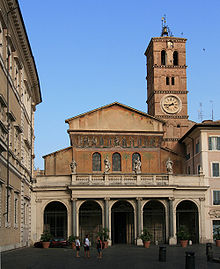Basilica di Santa Maria in Trastevere
| Basilica of Our Lady in Trastevere | |
|---|---|
| Basilica di Santa Maria in Trastevere | |

Façade of Santa Maria in Trastevere
|
|
| Basic information | |
| Location | Rome, Italy |
| Geographic coordinates | 41°53′22″N 12°28′11″E / 41.88944°N 12.46972°ECoordinates: 41°53′22″N 12°28′11″E / 41.88944°N 12.46972°E |
| Affiliation | Roman Catholic |
| Ecclesiastical or organizational status | Minor basilica |
| Leadership | vacant |
| Architectural description | |
| Architect(s) | Carlo Fontana |
| Architectural type | Church |
| Groundbreaking | 4th century |
| Completed | 1143 |
| Specifications | |
| Direction of façade | E |
| Length | 56 metres (184 ft) |
| Width | 30 metres (98 ft) |
| Width (nave) | 16 metres (52 ft) |
The Basilica of Santa Maria in Trastevere (Italian: Basilica di Santa Maria in Trastevere); English: Our Lady in Trastevere) is a titular minor basilica in the Trastevere district of Rome, and one of the oldest churches of Rome. The basic floor plan and wall structure of the church date back to the 340s, and much of the structure to 1140-43. The first sanctuary was built in 221 and 227 by Pope Callixtus I and later completed by Pope Julius I. The church has large areas of important mosaics from the late 13th century by Pietro Cavallini.
The inscription on the episcopal throne states that this is the first church in Rome dedicated to Mary, mother of Jesus, although some claim that privilege belongs to the Basilica di Santa Maria Maggiore. It is certainly one of the oldest churches in the city. A Christian house-church was founded here about 220 by Pope Saint Callixtus I (217–222) on the site of the Taberna meritoria, a refuge for retired soldiers. The area was made available for Christian use by Emperor Alexander Severus when he settled a dispute between the Christians and tavern-keepers, saying, according to the Liber Pontificalis "I prefer that it should belong to those who honor God, whatever be their form of worship." In 340, when Pope Julius I (337–352) rebuilt the titulus Callixti on a larger scale, it became the titulus Iulii in commemoration of his patronage and one of the original 25 parishes in Rome.
The church underwent two restorations in the fifth and eighth centuries and in 1140-43 it was re-erected on its old foundations under Pope Innocent II. Innocent II razed the church along with the recently completed tomb of the Antipope Anacletus II, his former rival. Innocent II arranged for his own burial on the spot formerly occupied by the tomb.
...
Wikipedia
